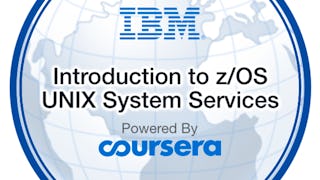This course presents the structure and control blocks of the z/OS BCP and system services. It prepares the new z/OS system programmer to identify potential bottlenecks and performance problems, perform initial error symptom gathering, and identify opportunities and requirements for tailoring an z/OS system. This course also provides prerequisite information needed for further training in specialized areas such as system measurement and tuning and system problem determination.

Enjoy unlimited growth with a year of Coursera Plus for $199 (regularly $399). Save now.

Recommended experience
Skills you'll gain
Details to know

Add to your LinkedIn profile
8 assignments
See how employees at top companies are mastering in-demand skills

There are 7 modules in this course
This unit sets the stage for the remainder of the course. The major functions of a z/OS system are reviewed, with emphasis on the relationships between components. The use of control blocks in an z/OS system is introduced, and basic IBM z System instruction execution and interrupt handling are described.
What's included
4 videos1 reading1 assignment
This unit presents what occurs during the initialization of the base control program of z/OS. It also discusses what control the system programmer has over customization of the Initial Program Load (IPL) process and what control the operator has over the IPL process.
What's included
5 videos1 reading1 assignment
z/OS BCP provides task management and supervisor services in order to enable the sharing of system resources and maximize the work that is processed in a given time. A solid understanding of these services is necessary to perform many system programmer activities. Examples include identifying bottlenecks, and determining status when a wait state or failure occurs.
What's included
4 videos1 reading1 assignment
z/OS and IBM z System provide the architectural foundation that allows greater flexibility and more design options in the development of application programs with needs that extend beyond the boundaries of a single address space.This unit examines the hardware and software facilities that enable a program to interact with other programs executing in other address spaces and use data in data spaces.
What's included
4 videos1 reading1 assignment
One of the primary functions of any computing system is the processing of data. Much of the data that is processed exists external to processor storage; that is, it might be out on a tape or DASD volume or it might be entered from a terminal. The handling of data requires the services of both software and hardware (channel subsystem and the devices attached to it).Understanding the roles of software and hardware in handling I/O requests is necessary for determining how to configure the hardware, how to tune the I/O configuration, and in analyzing I/O-related problems.
What's included
10 videos1 assignment
One of the major resources available to the users of an z/OS system is storage. Programs executing in the system, whether user applications or z/OS system routines, are vying for storage. Each of the areas of storage, however, is a limited resource, and use and availability must be managed to maintain program integrity. This managing of storage in z/OS is handled by three storage managers, virtual, real, and auxiliary. In this unit, we will gain an understanding to how each of the areas of storage is assigned, used, and managed is necessary for determining how much storage is required for your installation. This is also required for tuning your system to make the most efficient use of storage, and for analyzing storage-related failures.
What's included
18 videos1 reading1 assignment
The resolution of errors often requires the analysis of information produced at the time of the failure. The responsibility of the recovery termination manager (RTM) is to gather the failure indications, interface with system and application error recovery routines, and to generate the failure documentation. Understanding the function of the recovery termination manager and recovery routines is helpful for analyzing the failure documentation and for determining how to tune the system for the control of the documentation produced.
What's included
5 videos2 assignments
Instructor

Offered by
Explore more from Data Management
 Status: Preview
Status: Preview Status: Free Trial
Status: Free Trial Status: Preview
Status: Preview Status: Free Trial
Status: Free Trial
Why people choose Coursera for their career





Open new doors with Coursera Plus
Unlimited access to 10,000+ world-class courses, hands-on projects, and job-ready certificate programs - all included in your subscription
Advance your career with an online degree
Earn a degree from world-class universities - 100% online
Join over 3,400 global companies that choose Coursera for Business
Upskill your employees to excel in the digital economy
Frequently asked questions
To access the course materials, assignments and to earn a Certificate, you will need to purchase the Certificate experience when you enroll in a course. You can try a Free Trial instead, or apply for Financial Aid. The course may offer 'Full Course, No Certificate' instead. This option lets you see all course materials, submit required assessments, and get a final grade. This also means that you will not be able to purchase a Certificate experience.
When you purchase a Certificate you get access to all course materials, including graded assignments. Upon completing the course, your electronic Certificate will be added to your Accomplishments page - from there, you can print your Certificate or add it to your LinkedIn profile.
Yes. In select learning programs, you can apply for financial aid or a scholarship if you can’t afford the enrollment fee. If fin aid or scholarship is available for your learning program selection, you’ll find a link to apply on the description page.
More questions
Financial aid available,

